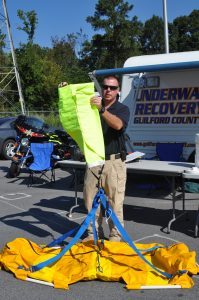KN, p. 223 “Underwater Evidence and Recovery: Searches”
Read Part 1: “Underwater Evidence and Body Recovery: Lakes and Bodies” here.
Part 2 of “Underwater Evidence and Recovery” covers some of the search methods available to rescue and recovery dive teams.


The divers each have different roles. In a three member team, one does the bagging and tagging and the other has primary responsibility to bring the evidence or a body back. The divers try to stay with the bag on the way up, so it doesn’t get snagged on rebar, fish hooks, or other debris known to be present in ponds and swamps. The large pond near my house has castoff evergreen trees around the edges – great hiding places for fish, but tough to work around when moving retrieval equipment near them.
One search method for remains thought to be in shallow, but cloudy, ponds is to form a ‘skirmish line.’ The team members lock arms and walk the area, to see if they can bump into the body. In deeper water, grappling hooks might be used if there is a suspicion that a body is snagged on a log or other large object. Sometimes, people drown in their cars after going off a road, and must be extricated before the car is towed out.
As upsetting as it might be to the families of missing loved ones, searches cost money. The men and women in charge of the searches must weigh their past experience in finding people under different circumstances and decide when to call it off officially.
Highly experienced divers have found bodies and evidence at a depth of fifteen feet, where it is extremely cold and almost pitch black. It’s not always possible to recover anything at that depth, with currents, storms, or toxic waste in the mix.
Searches are conducted with ropes because of the zero visibility. The bottoms of lakes are silky and murky and the divers see shades of dark. Lights don’t help because they bounce off particles in the water. The divers have to work by feel.
During training, already certified divers practice evidence recovery in clear water, then duplicate the exercise in black water. Some practice dives are done while wearing blackout masks. Trainees have been known to close their eyes and hum when getting used to the darkness. As one diver said, “It’s scary down there the first few times.” The job is definitely not for everyone. I certainly couldn’t do it!

The procedure after finding evidence or a body is to bag it while still in the water. The body bag has fine mesh on side to let the water out, but not the evidence. A design improvement created 6 points of attachment to lift the body bag, allowing more stability during the lift.
For a drowning, the divers buoy the body. For a homicide, the divers wait with a body bag and buoy it. Attaching a buoy allows for easier lifting.
Once out of the water, a record of the chain of custody is kept on the outside of the bag by the Medical Examiner.
Experts say that drowning deaths can be avoided by following some simple rules:
“Ninety percent of our fatalities could be prevented if they were wearing a life jacket (while boating),” North Carolina Wildlife Resources Commission Officer Hannah Shively explained.
If you see someone in distress, try and throw an object towards them, whether it’s a stick, fishing pole, cooler, or life jacket, to pull them to safety. Don’t let yourself or anyone else become a statistic.
*Photos taken by Patti Phillips at two Writers’ Police Academy events in North Carolina. Many thanks to the members of the Guilford County Sheriff’s Department for their informative presentations and to Lee Lofland for organizing the annual events.
KN, p. 223 “Underwater Evidence and Recovery: Searches” Read More »








